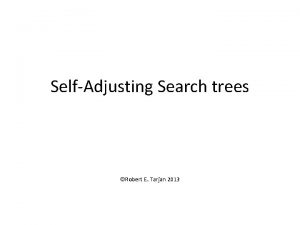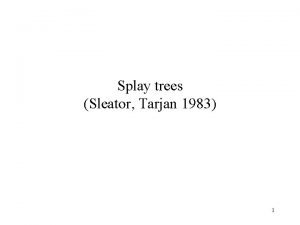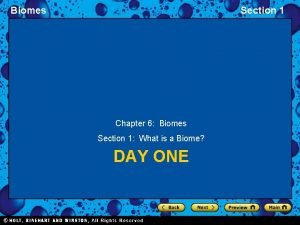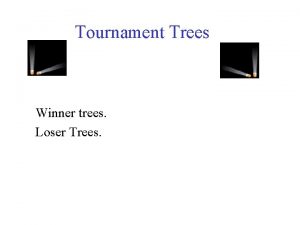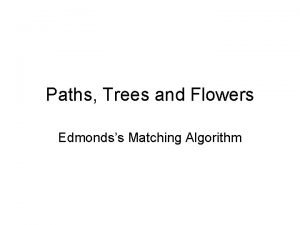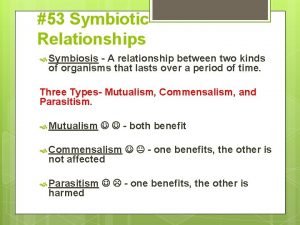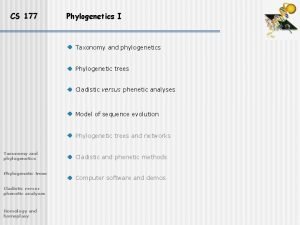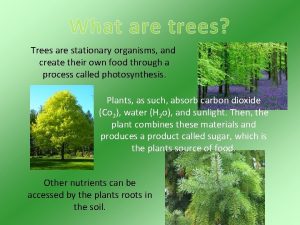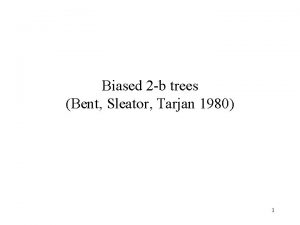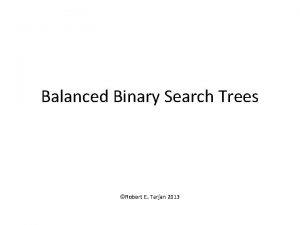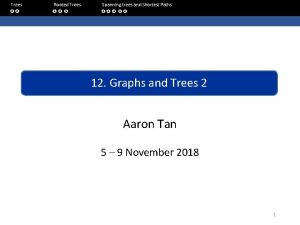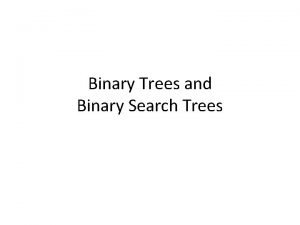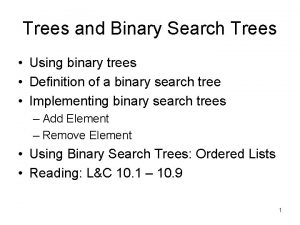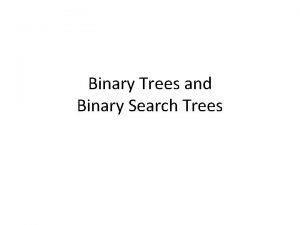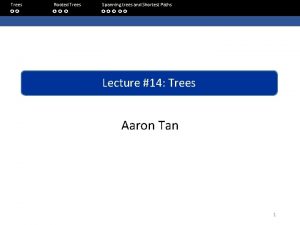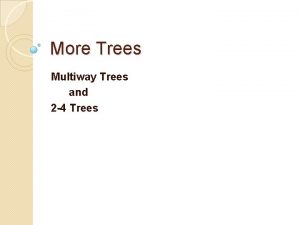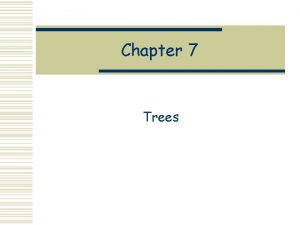Dynamic trees Steator and Tarjan 83 1 Operations


























- Slides: 26

Dynamic trees (Steator and Tarjan 83) 1

Operations that we do on the trees Maketree(v) w = findroot(v) (v, c) = mincost(v) addcost(v, c) link(v, w, r(v, w)) cut(v) findcost(v) 2

Simple case -- paths c d e f Assume for a moment that each tree T in the forest is a path. We represent it by a virtual tree which is a simple splay tree. a e c f a b b d 3

Findroot(v( Splay at v, then follow right pointers until you reach the last vertex w on the right path. Return w and splay at w. 4

Mincost(v( With every vertex x we record cost(x) = the cost of the edge (x, p(x)) We also record with each vertex x mincost(x) = minimum of cost(y) over all descendants y of x. 1 a b 3 3, 1 c e d d 7, 1 2, 2 a f e 4, 4 b 1, 1 2 4 7 c f , 5

Mincost(v( Splay at v and use mincost values to search for the minimum Notice: we need to update mincost values as we do rotations. y x A x C B y A B C 6

Addcost(v, c( Rather than storing cost(x) and mincost(x) we will store cost(x) = cost(x) - cost(p(x)) min(x) = cost(x) - mincost(x) 1 a 3 b 3, -4, 2 2 c a e d f d 7, 7, 6 e 4, -3, 0 b 1, -2, 0 4 7 c 2, -1, 0 f , , 0 Addcost(v, c) : Splay at v, cost(v) += c cost(left(v)) -= c similarly update min 7

Addcost(v, c) (cont( Notice that now we have to update cost(x) and min(x) through rotations w v v C b A B w A b B C cost’(v) = cost(v) + cost(w) cost’(w) = - cost(v) cost’(b) = cost(v) + cost(b) 8

Addcost(v, c) (cont( Update min: w v v C b A B w A b B C min’(w) = max{0, min(b) - cost’(b), min(c) - cost(c)} min’(v) = max{0, min(a) - cost(a), min’(w) - cost’(w)} 9

Link(v, w, c), cut(v( Translate directly into catenation and split of splay trees if we talk about paths. Lets do the general case now. 10

The virtual tree • We represent each tree T by a virtual tree V. The virtual tree is a binary tree with middle children. left middle right Think of V as partitioned into solid subtrees connected by dashed edges What is the relation between V and T ? 11

Actual tree a b c d f e g i h j l k m r n o p q s t u v w 12

Path decomposition a Partition T into disjoint paths b c d f e g i h j l k m r n o p q s t u v w 13

Virtual trees (cont( Each path in T corresponds to a solid subtree in V f l q b c i p The parent of a vertex x in T is the successor of x (in symmetric order) in its solid subtree or the parent of the solid subtree if x is the last in symmetric order in this subtree a j r h g m k d o v w e n t u s 14

Virtual trees (cont( f a l b q c d f e g r n p o p a j r l k m c i i h j b q h g m k d o v s t w u e n t u s v w 15

Virtual trees (representation( Each vertex points to p(x) to its left son l(x) and to its right son r(x). A vertex can easily decide if it is a left child a right child or a middle child. Each solid subtree functions like a splay tree. 16

The general case Each solid subtree of a virtual tree is a splay tree. We represent costs essentially as before. cost(x) = cost(x) - cost(p(x)) or cost(x) is x is a root of a solid subtree min(x) = cost(x) - mincost(x) (where mincost is the minimum cost within the subtree) 17

Splicing Want to change the path decomposition such that v and the root are on the same path. Let w be the root of a solid subtree and v a middle child of w w u w ==> v right v u right Want to make v the left child of w. It requires: cost’(v) = cost(v) - cost(w) cost’(u) = cost(u) + cost(w) min’(w) = max{0, min(v) - cost’(v), min(right(w))- cost(right(w))} 18

Splicing (cont( What is the effect on the path decomposition of the real tree ? w u w ==> right v a b v right u a ==> b w w u u v v 19

Splaying the virtual tree Let x be the vertex in which we splay. We do 3 passes: 1) Walk from x to the root and splay within each solid subtree After the first pass the path from x to the root consists entirely of dashed edges v w x 2) Walk from x to the root and splice at each proper ancestor of x. Now x and the root are in the same solid subtree 3) Splay at x Now x is the root of the entire virtual tree. 20

Dynamic tree operations w = findroot(v) : Splay at v, follow right pointers until reaching the last node w, splay at w, and return w. (v, c) = mincost(v) : Splay at v and use cost and min to follow pointers to the smallest node after v on its path (its in the right subtree of v). Let w be this node, splay at w. addcost(v, c) : Splay at v, increase cost(v) by c and decrease cost(left(v)) by c, update min(v) link(v, w, r(v, w)) : Splay at v and splay at w and make v a middle child of w cut(v) : Splay at v, break the link between v and right(v), set cost(right(v)) += cost(v) 21

Dynamic tree (analysis( It suffices to analyze the amortized time of splay. An extension of the access lemma. • Assign weight 1 to each node. The size of a node is the total number of descendants it has in the virtual tree. Rank is the log of the size. Potential is c times the sum of the ranks for some constant c. (So we can charge more than 1 for each rotation) xk x 1 x 22

Dynamic tree (analysis( pass 1 takes 3 clogn + k pass 2 takes k k=#dashed edges on the path pass 3 takes 3 clogn + 1 – (c-1)(k-1) 23

Proof of the access lemma (cont( y (3) zig ==> x A x C B y A B C amortized time(zig) = 1 + r’(x) + r’(y) - r(x) - r(y) 1 + r’(x) - r(x) 1 + 3(r’(x) - r(x)) 24

Proof of the access lemma (cont( ==> y x A x z (1) zig - zig D y A C z B B C D amortized time(zig-zig) = 2 + r’(x) + r’(y) + r’(z) - r(x) - r(y) - r(z) = 2 + r’(y) + r’(z) - r(x) - r(y) 2 + r’(x) + r’(z) - 2 r(x) 2 r’(x) - r’(z) + r’(x) + r’(z) - 2 r(x) = 3(r’(x) - r(x)) 25

Proof of the access lemma (cont( z (2) zig - zag x ==> y x A B y D A z B C D C Similar. (do at home) 26
 Robert e tarjan
Robert e tarjan Robert e tarjan
Robert e tarjan Tarjan+xxx
Tarjan+xxx Tarjan 1983
Tarjan 1983 Tarjn
Tarjn Kosaraju's algorithm
Kosaraju's algorithm Dynamic dynamic - bloom
Dynamic dynamic - bloom A plain full of grasses and scattered trees and shrubs
A plain full of grasses and scattered trees and shrubs Venn diagram of coniferous and deciduous trees
Venn diagram of coniferous and deciduous trees Tropical rainforest and temperate forest venn diagram
Tropical rainforest and temperate forest venn diagram The trees danced back and forth in the wind
The trees danced back and forth in the wind Classification and regression trees (cart)
Classification and regression trees (cart) Tournament tree
Tournament tree Song of the trees theme
Song of the trees theme Loser tree
Loser tree Paths trees and flowers
Paths trees and flowers The wind whispered her name as it blew through the trees
The wind whispered her name as it blew through the trees Kapok trees and orchids symbiotic relationship
Kapok trees and orchids symbiotic relationship Unscaled phylogenetic tree
Unscaled phylogenetic tree Similarities between coniferous and deciduous trees
Similarities between coniferous and deciduous trees The tree poem
The tree poem Hardwood and softwood trees
Hardwood and softwood trees Winner tree and loser trees
Winner tree and loser trees Multiplication rule of counting
Multiplication rule of counting If 16 700 j of work is done
If 16 700 j of work is done What are trees
What are trees Coniferous tree identification
Coniferous tree identification
